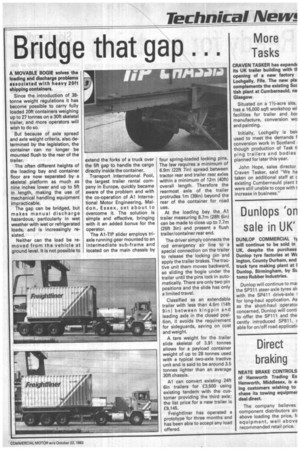Bridge that gap . . .
Page 17

If you've noticed an error in this article please click here to report it so we can fix it.
A MOVABLE BOGIE solves the loading and discharge problems associated with heavy 20ft shipping containers.
Since the introduction of 38tonne weight regulations it has become possible to carry fully loaded 20ft containers weighing up to 27 tonnes on a 30ft skeletal trailer, and more operators will wish to do so.
But because of axle spread and axle weight criteria, also determined by the legislation, the container can no longer be mounted flush to the rear of the trailer.
The often different heights of the loading bay and container floor are now separated by a skeletal platform as much as nine inches lower and up to 5ft in length, making the use of mechanical handling equipment impracticable.
The gap can be bridged, but makes manual discharge hazardous, particularly in wet weather with wet or refrigerated loads, and is increasingly resisted.
Neither can the load be removed from the vehicle at ground level. It is not possible to extend the forks of a truck over the 5ft gap to handle the cargo directly inside the container.
Transport International Pool, the largest trailer rental company in Europe, quickly became aware of the problem and with the co-operation of Al International Motor Engineering, Maldon, Essex, set about to overcome it. The solution is simple and effective, bringing with it an added bonus for the operator.
The Al-TIP slider employs triaxle running gear mounted to an intermediate sub-frame and located on the main chassis by four spring-loaded locking pins. The law requires a minimum of 6.9m (22ft 7in) spread between tractor rear and trailer rear axles within a minimum of 12m (40ft) overall length. Therefore the rearmost axle of the trailer protrudes 1m (39in) beyond the rear of the container for road use.
At the loading bay the Al trailer measuring 8.7m (28ft 6in) can be made to close up to 7.7m (26ft 3in) and present a flush trailer/container rear end.
The driver simply connects the rod emergency air line to a special connection on the trailer to release the locking pin and apply the trailer brakes. The tractive unit them moves backward, so sliding the bogie under the trailer until the pins lock in automatically. There are only two pin positions and the slide has only a limited travel.
Classified as an extendable trailer with less than 4.5m (14ft 9in) between kingpin and leading axle in the closed position, it avoids the requirement for sideguards, saving on cost and weight.
A tare weight for the trailer slide skeletal of 3.91 tonnes allows for a payload container weight of up to 28 tonnes used with a typical two-axle tractive unit and is said to be around 3.5 tonnes lighter than an average 30ft chassis.
Al can convert existing 24ft 6in trailers for £3,500 using existing tandem with the customer providing the third axle; the list price for a new trailer is £9,145.
Freightliner has operated a prototype for three months and has been able to accept any load offered,
































































































